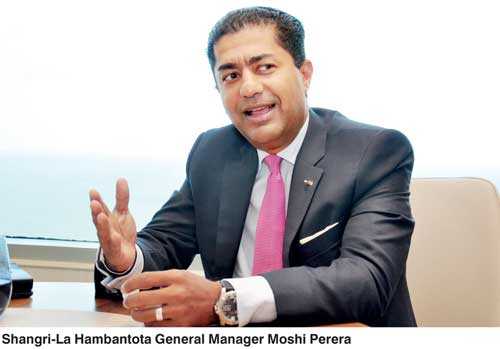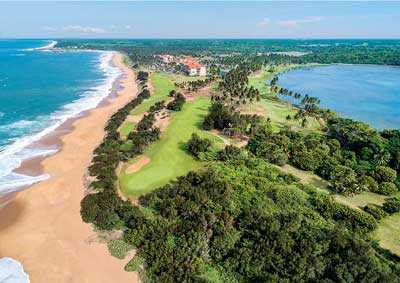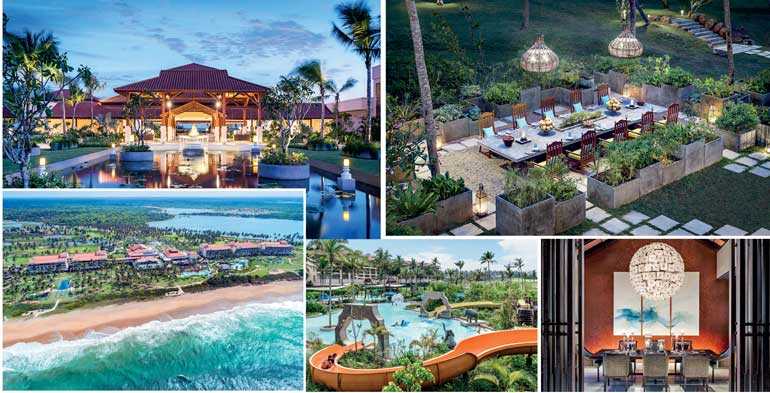Saturday Apr 20, 2024
Saturday Apr 20, 2024
Monday, 25 June 2018 00:00 - - {{hitsCtrl.values.hits}}
By Madushka Balasuriya
With its massive 150-acre property complete with a picturesque 18-hole golf course, world-class spa facilities, and a host of excursions for kids and adults alike, the Shangri-La Hambantota is a tourist’s and hotelier’s dream, but since its opening in June 2016, getting people there has been its biggest challenge.

The property averages around 50% occupancy year round – while certainly not poor, there is definitely scope for improvement. Something new General Manager Moshi Perera has squarely set in his crosshairs.
Perera has been in the role since November 2017, prior to which he was General Manager for the Norfolk & Fairmont Mara Safari Club in Kenya. There he had been a key part of operational activities and developing the brand in East Africa, experience he hopes will hold him good stead during his term in Sri Lanka.
“A brochure and a picture can only say so much,” he explains in a sit-down interview with Daily FT. “The hard part is getting people to buy into it.
“Because it’s easy when people come and experience it – then they’re sold instantly – but it’s just getting people to come see it.”
“There are a lot of things in marketing that the Government could do”
While the hotel has been doing its part in bringing down bloggers and journalists to spend time and enjoy the property, it is still most definitely an area in which Perera and Shangri-La are looking for a little help from the Government.
The recent halting of flights by Fly Dubai to the Mattala International Airport was unhelpful, to say the least, with Shangri-La having put in a lot of hours cultivating relationships and promotions in the Middle East. And though Perera is hopeful of pressure being put to bring back Fly Dubai or similar operators back to Mattala, the exact impact of Fly Dubai’s halting of services remains to be seen.
“Fly Dubai stopping is unfortunate because we’ve put in a lot of time and effort into developing that route,” he laments.
“It’s a four-hour journey from the Middle East and Gulf market – and apart from the gulf residence there are a lot of expats there – so we’ve seen a lot of them coming for the holiday seasons. And if you look at the weather and climate there between May to September; four hours away you’ve got sand, sea, natural vegetation and great temperatures compared to what’s in the Middle East. We’ve also found over December, January, February, that there were a lot of visitors from the Gulf.”
And for Perera, from a marketing standpoint, he feels the Government could certainly be doing more especially in terms of freshening up their approach to promoting the country abroad. “There are a lot of things in marketing that the Government could do. They do invest in the trade shows and trade fairs, but I think now is the time to take it to the next level. We’re still stuck on that traditional approach.
“They could also support on the golfing front – the one we’re doing next is an international event that could be something they could support. That would also get investors to come and put money into some more golf courses.”
“If we’re doing around 50% occupancy on average year round without that infrastructure, I think that’s a great indicator of what our possibilities are”
That said, he is optimistic of improvements in the coming year with the long-promised infrastructure in and around Hambantota – despite uncertainty surrounding the funding and future of the Mattala Airport and Hambantota Sea Port – finally starting to come to fruition.
The extension of the expressway from Matara to Hambantota is expected to be completed in the first quarter of 2019, with the project expected to link the Hambantota Port and Mattala Airport with Colombo, as well as the north of the country through the Outer Circular Highway, Colombo - Katunayake Expressway and the proposed Northern Expressway.
With the average length of stay at the Shangri-La Hambantota at present hovering at little over a week, no doubt boosted by its golf course and family-centric activities, cutting down the travel time from Colombo – which stands at roughly four hours now – will definitely improve the viability of day trips and more frequent visits, believes Perera.
“If we’re doing around 50% occupancy on average year round without that infrastructure, I think that’s a great indicator of what our possibilities are. You see the potential is there, it’s just waiting to come to life. The highway to Matara already breaks the journey down and I think once that connection, even to Tangalle, is open, that will also be a huge saving. And then direct to Hambantota,” he notes.
“If that happens I think the dynamics will change definitely, even for golf. You know the golfing community is quite small and starting to grow, and golfers by nature like to play multiple courses. And I think there’s an opportunity for SL tourism with golf, where having that connectivity with drive time reduced to two hours, there’ll be a lot more Colombo golfers coming for a day trip.”
Moreover, he also expects the expansion of the Southern Expressway to add to the service already being provided by Shangri-La in terms of being a hub of sorts for wildlife and deep sea excursions, while simultaneously positioning the Mattala Airport as a genuine arrival and departure gateway.
“A lot of our clients our going on wildlife excursions as part of our activities to do. They go to Udawalawe to do the safari there, then go to the Elephant Orphanage, and Yala. There’s a bird park there as well, and part of the beauty of it is the infrastructure is still not developed, so there’s still more to discover for people to do. It’s also just an hour-and-a-half to Mirissa, while some people even go to Kataragama. So we package them and give them the options. That’s why the average length of stay seems to grow. People come and stay and then do these excursions.
“Another thing we see is people coming in from Colombo, they’ve gone to the cultural Triangle, come through Kandy, and then come here for rest before they go back. This is another opportunity because if the airport was functional it could be an entry/exit point from both sides – Colombo and Mattala.”

“Hambantota has a bit of serenity and peace, no hotel after hotel after hotel; with 150 acres, even at our peak, there’s space for everybody”
So while the future is clearly bright, Perera is also keen to expand on the options available to them in the present. First and foremost of which is properly utilising the unique position the hotel is in at the moment, wherein there are little to no other entertainment options in the area.
This is something that, for Perera, feels a bit like a double-edged sword; on the one hand, it offers visitors a sense of peace and tranquillity unlikely to be found elsewhere in the country, but on the other it puts a lot of pressure on the hotel to make a visitor’s stay as memorable as possible.
“Hambantota has a bit of serenity and peace. No hotel after hotel after hotel. With 150 acres, even at our peak, there’s space for everybody. That’s where the difference would be in terms of length of stay with other hotels; about three years ago the average length of stay was about three nights, now it’s gone to about seven to eight nights,” he explains.
“But now the problem is that we have the three main restaurants, but we need a few more areas, both in quantity and variety, because when you have people coming for about one or two weeks, having only three places to eat has a real monotony.
“Also outside of the hotel premises, not much has developed in terms of hotel infrastructure. So we’re kind of at their mercy a little bit to keep them entertained. So now we’ve come up with different themes.
“For example we throw in a Brazilian Churrasco week where you can have unlimited meat barbecued. Then within the restaurants we have seafood night where we try and get local produce from the fisherman, a duck night, a street hawker night. We also have the artisan village, which is another thing we’re working on to bring in the local culture. Those are the sort of features we’re trying to add a little bit more of.”
With this in mind, Perera is also eager to see more private investment in the area, which he hopes will force the government’s hand somewhat in looking for an expedited solution to the issues surrounding the infrastructure in the area, as well increase the global visibility of Hambantota as a brand.
“On the one side there is a supply and demand issue, where at the moment there is some oversupply, so it of course creates competition. But why are those investors coming in there and looking to put properties? I think that speaks towards the viability of the area.
“The positive side is that it’s going to create more jobs and infrastructure. The other positive is that each of these organisations have marketing budgets where they can start talking and spreading the word.”
“If you look at it our tourism has really started to peak in the last two-three years, and now Sri Lanka is a hot destination – and that’s without the marketing; imagine what could be done with it”
Another key way in which the Shangri-La Hambantota is looking to market itself is through golf tourism. The hotel recently began partnering with the Sri Lanka Golf Union in providing training for both young golfers and caddies, while also promoting Sri Lanka as a paradise golfing location with its international partners. A members’ tournament set to be held from 13-15 July is yet another extension of this endeavour.
“The golfing is now starting to take off. The hotel is now coming up to two years, the golf course opened almost a year later and it’s maturing very quickly. The golf course is pristinely manicured - it’s in three phases – you’ve got the coconut plantation feel, the dunes and seaside links feel, and we have the area which is reclaimed from a former sapphire mine.
“The nice thing about it is that with all of the tree planting and flora and fauna that has been put back in we’re seeing natural life, bird life, coming back. The peacocks are now starting to rest and we’ve seen the first baby peacocks coming, which is a good sign that the nature is starting to settle. And we’ve also had dolphins and whales come by.”
On the whole, these plans along with pushes into the MICE (Meetings, Incentives, Conferences, and Exhibitions) and destination weddings markets, as well as package deals with Shangri-La Colombo, there’s no denying the Shangri-La Hambantota is well placed to capitalise on growing tourist interest in the deep south.
And despite unsurprising amounts of red tape, Perera is unshaken in his belief that the country’s tourist industry is on the verge of truly blossoming.
“We found the Australian market was one that surprised us. We’re trying to capitalise on that. We’re working on weddings, closely with Colombo and Maldives. “But really, if you look at it our tourism has really started to peak in the last two to three years, and now Sri Lanka is a hot destination – and that’s without the marketing. Imagine what could be done with it.”
Pix by Sameera Wijesinghe
